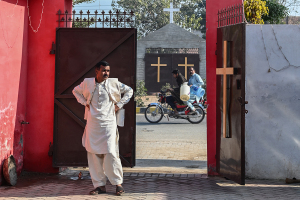NY-Based Photographer Enters 6 Maximum Security Prisons to Capture Inmates Embracing Their Religion
New York based photographer Serge J-F. Levy, visited six maximum security prisons across the country between 2002 and 2003 to photograph inmates embrace spirituality in a series of images called, "Religion in Prison."
The project was sparked by Levy's own curiosity and what he found through each interaction with those incarcerated who are Christian, Jewish, Wiccan, Muslim and Buddhist, and how religion brings out their softer side, despite their labels as criminals.
"There's this sincere desire on the part of many inmates to try to understand the state of their soul," Levy said, according to Slate.com. "They're trying to understand their predicament, and I think that spirituality in prison not so infrequently dovetails with a form of analysis or therapy. I think there's a sense of introspection and evaluation of one's life that happens within these religious environments."
He added, "Without having any personal predisposition to any religious activity, but having a fascination with how people can work on their spirituality and healing their souls, I was interested in how this was happening in an environment that seemed to be everything but conducive to that."
During the time that he spent in correctional facilities in New York, Pennsylvania, Minnesota and Louisiana, among others, Levy witnessed religious experiences in which inmates demonstrated joyous emotions that they otherwise would not display, as he saw during a service in which some were baptized in a laundry cart filled with water.
"To me, that was the quintessential religious experience," Levy said. "The music and the singing, that sort of excitement I think is contagious in any religious environment, but I think the fervor is just so peaked in those places."
It was important to Levy that he capture a wide range of religious experiences, however, persuading prison administrators and then the inmates themselves about his intentions was no easy feat.
"I wasn't going in and looking for the cracks in the toilet bowl and poor inmate conditions. I was looking at something that could possibly make a prison and its staff look better," said Levy.
His first installment of images was from Greenhaven maximum security prison in New York. He gained access there after meeting an employee who worked in the mailroom who then connected him with another employee, creating a network chain along the way before being allowed in. After his work at that facility, Levy had amassed enough images to showcase his work to other prisons about his desire to photograph their inmates.
"It's a real challenge to convince people of your intentions, and I felt very lucky to have my intentions aligned with something that was pretty hard to see a negative take on it," said Levy.
During one of his visits, Levy was present when he heard prisoners describe their experiences with rape. It was moments like those that he witnessed their vulnerable and human side despite being there because of their wrongdoings.
"I had to put down my camera. I was incapable of working because it was just too much," Levy said, recounting his reaction to the conversations about rape. "It really brought together what the story was about. We don't know how people arrive in prison until we start to listen to how they arrived there. There's no excuse for the damage a felon criminal has done, but there is possibly an explanation."
While Levy captured photos of inmates embracing their religion in private or among others in a group setting, his sole purpose was to encapsulate the spiritual freedom that inmates, who are not only marginalized by society on the outside but within their own prison facilities too, get to experience in spite of their solitary confinement.
"I was looking for a variety of experiences," said Levy. "I wanted to really get everything from that public experience all the way down to the private experience. Because that's the breadth of what religion and spiritually means to people."





























